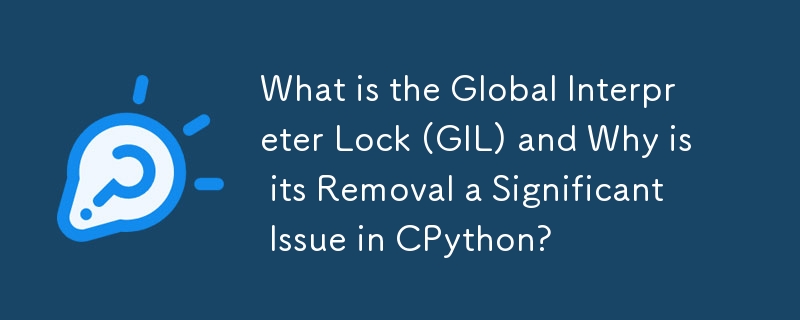 Backend Development
Backend Development
 Python Tutorial
Python Tutorial
 What is the Global Interpreter Lock (GIL) and Why is its Removal a Significant Issue in CPython?
What is the Global Interpreter Lock (GIL) and Why is its Removal a Significant Issue in CPython?
What is the Global Interpreter Lock (GIL) and Why is its Removal a Significant Issue in CPython?

Understanding the Global Interpreter Lock (GIL) in CPython
Introduction:
The Global Interpreter Lock (GIL) is a critical aspect of CPython, the most widely used implementation of the Python programming language. When exploring the concept of the GIL, it's essential to understand its purpose, implications, and the reasons why its removal has been a major topic of discussion in the Python community.
Understanding the GIL:
The GIL is a mutex that guarantees that only one thread in the Python interpreter may execute Python bytecode at a given time. This design was implemented to ensure thread safety in the Python interpreter and prevent data corruption.
GIL's Impact on Concurrency:
On multi-core systems, the GIL creates a limitation for parallelism. Since only one thread can execute Python bytecode at a time, it becomes a bottleneck when coordinating I/O-intensive tasks across multiple threads. This bottleneck arises because GIL prevents multiple threads from utilizing the available processing cores effectively.
Why Removing the GIL is Important:
With the increasing prevalence of multi-core CPUs, the GIL's inherent restraint on concurrency has become more problematic. Removing the GIL would enable Python to scale more efficiently in multi-threaded environments, maximizing the performance potential of modern computing architectures.
Current Status and Future Prospects:
The removal of the GIL from CPython has been a widely debated topic in the Python community. Despite its impact on concurrency, removing the GIL is not trivial and introduces other challenges. However, research and efforts are ongoing to explore alternative approaches to thread safety in Python.
Other Python Implementations:
It's worth noting that the GIL is exclusive to CPython. Other Python implementations like Jython (running on JVM) and IronPython (.NET) do not have a GIL, enabling them to take advantage of concurrency more effectively in multi-threaded contexts.
The above is the detailed content of What is the Global Interpreter Lock (GIL) and Why is its Removal a Significant Issue in CPython?. For more information, please follow other related articles on the PHP Chinese website!

Hot AI Tools

Undresser.AI Undress
AI-powered app for creating realistic nude photos

AI Clothes Remover
Online AI tool for removing clothes from photos.

Undress AI Tool
Undress images for free

Clothoff.io
AI clothes remover

Video Face Swap
Swap faces in any video effortlessly with our completely free AI face swap tool!

Hot Article

Hot Tools

Notepad++7.3.1
Easy-to-use and free code editor

SublimeText3 Chinese version
Chinese version, very easy to use

Zend Studio 13.0.1
Powerful PHP integrated development environment

Dreamweaver CS6
Visual web development tools

SublimeText3 Mac version
God-level code editing software (SublimeText3)

Hot Topics
 How to solve the permissions problem encountered when viewing Python version in Linux terminal?
Apr 01, 2025 pm 05:09 PM
How to solve the permissions problem encountered when viewing Python version in Linux terminal?
Apr 01, 2025 pm 05:09 PM
Solution to permission issues when viewing Python version in Linux terminal When you try to view Python version in Linux terminal, enter python...
 How to avoid being detected by the browser when using Fiddler Everywhere for man-in-the-middle reading?
Apr 02, 2025 am 07:15 AM
How to avoid being detected by the browser when using Fiddler Everywhere for man-in-the-middle reading?
Apr 02, 2025 am 07:15 AM
How to avoid being detected when using FiddlerEverywhere for man-in-the-middle readings When you use FiddlerEverywhere...
 How to teach computer novice programming basics in project and problem-driven methods within 10 hours?
Apr 02, 2025 am 07:18 AM
How to teach computer novice programming basics in project and problem-driven methods within 10 hours?
Apr 02, 2025 am 07:18 AM
How to teach computer novice programming basics within 10 hours? If you only have 10 hours to teach computer novice some programming knowledge, what would you choose to teach...
 How to efficiently copy the entire column of one DataFrame into another DataFrame with different structures in Python?
Apr 01, 2025 pm 11:15 PM
How to efficiently copy the entire column of one DataFrame into another DataFrame with different structures in Python?
Apr 01, 2025 pm 11:15 PM
When using Python's pandas library, how to copy whole columns between two DataFrames with different structures is a common problem. Suppose we have two Dats...
 How does Uvicorn continuously listen for HTTP requests without serving_forever()?
Apr 01, 2025 pm 10:51 PM
How does Uvicorn continuously listen for HTTP requests without serving_forever()?
Apr 01, 2025 pm 10:51 PM
How does Uvicorn continuously listen for HTTP requests? Uvicorn is a lightweight web server based on ASGI. One of its core functions is to listen for HTTP requests and proceed...
 How to handle comma-separated list query parameters in FastAPI?
Apr 02, 2025 am 06:51 AM
How to handle comma-separated list query parameters in FastAPI?
Apr 02, 2025 am 06:51 AM
Fastapi ...
 How to solve permission issues when using python --version command in Linux terminal?
Apr 02, 2025 am 06:36 AM
How to solve permission issues when using python --version command in Linux terminal?
Apr 02, 2025 am 06:36 AM
Using python in Linux terminal...
 How to get news data bypassing Investing.com's anti-crawler mechanism?
Apr 02, 2025 am 07:03 AM
How to get news data bypassing Investing.com's anti-crawler mechanism?
Apr 02, 2025 am 07:03 AM
Understanding the anti-crawling strategy of Investing.com Many people often try to crawl news data from Investing.com (https://cn.investing.com/news/latest-news)...





